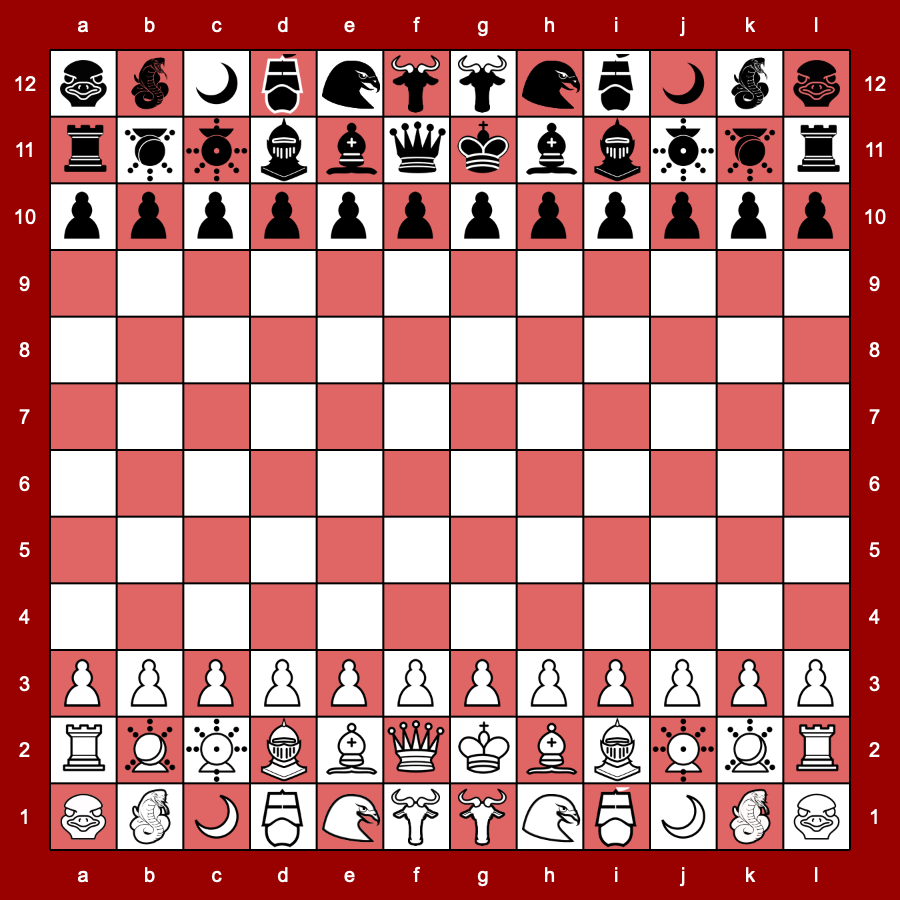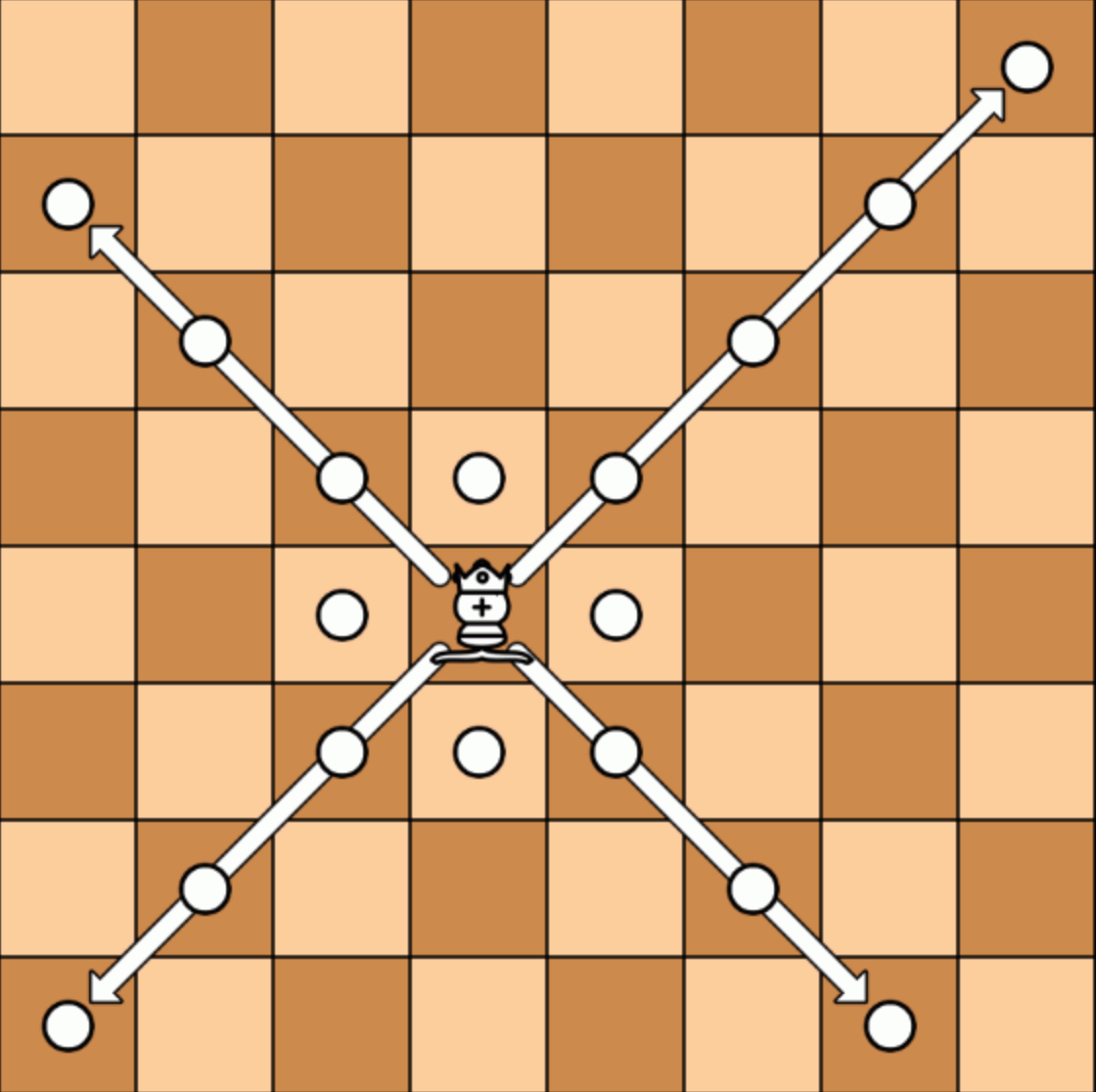Obento Chess
This large chess variant is the fruit of a collaboration between Eric Silverman and Jean-Louis Cazaux. Silverman had the initial idea of blending elements of large shogis into a giant Western styled chess variant, with the incorporation of bent-riders such as the Osprey and the Ostrich. Both inventors selected the pieces together, and defined their promotions after some very animated discussions. They elaborated the name of the game as a pun, recalling the presence of bent-riders in a Japanese manner.
The setup and promotion rules have been fixed after numerous tests with the help of the AI AI tool (Silverman has coded tens of chess variants in AI AI).
Setup
The dozenal board of 12x12 squares is used for Obento Chess. Each side has 36 pieces positioned on the first three rows of each player.
- The 3rd row is occupied by 12 Pawns.
- The 2nd row has the King (g2), Queen (f2), Bishops (e2, h2), Marquis (d2, i2), Gold Pashtuns (c2, j2), Silver Pashtuns (b2, k2) and Rooks (a2, l2).
- On the 1st row there are Ostriches (a1, l1), Snakes (b1, k1), Wizards (c1, j1), Ships (d1, i1), Ospreys (e1, h1) and Wildebeests (f1, g1).
Black mirrors White's pieces.
Initial Setup:

Pieces
King: moves 1 step in every (8) directions on a not attacked square. The King is in check if it is attacked by one or several enemy pieces. It is forbidden to play a move letting his King in check. Apart from castling (see below), it is identical to standard chess.
Queen: slides to any square along the file, the rank, or a diagonal on which it stands. Identical to standard chess.
Rook: moves to any square along the file or the rank on which it stands. Identical to standard chess (except there is no castling)
Bishop: slides to any square along a diagonal on which it stands. Identical to standard chess
Knight: a (2,1) jumper, it jumps to the opposite square of a 2x3 rectangle. No matter what the intermediate square contains. Identical to standard chess
Admiral: it is another compound piece that moves as a Rook or a non-royal King. That means that it is a Rook that can also step one space diagonally. It corresponds to the Dragon King that is found in Shogi.

Missionary: it is another compound piece that moves as a Bishop or a non-royal King. That means that it is a Bishop that can also step one space orthogonally. It corresponds to the Dragon Horse that is found in Shogi.

Pawn: it may step one, two or three squares forward on its first move; after that, only one square at a time. The Pawn may not move one square initially and then two on a later move (as it does in some variants). It captures one square diagonally forward identically to standard chess.

Rules
En passant capture is possible whenever a Pawn, by either by a double or triple step, passes through a square controlled by an opposing Pawn. Apart from this, the Pawn’s rules remain standard.
Castling: the King may castle with either Rook by stepping three squares towards it while the Rook leaps to one square past the King, so that the King and Rook end up adjacent to each other. Restrictions are the same as in chess.
Promotions: not only the Pawns, but several other pieces may be promoted, on entering the last three rows of the board. The Pawn promotes to the Flying Ox, Marquis to Squirrel, Ship to Ostrich, Snake to Osprey, Wizard to Caliph, Wildebeest to Wildeguard, Bishop to Dragon Horse, Rook to Dragon King, Silver Pashtun to Silver Rider and Gold Pashtun to Gold Rider.
Notes
The influence of Japanese shogi and its large variants is obvious. This starts with the promotion zone, which covers all the starting rows of the opponent. The idea of extending the promotion to many non-Pawn pieces is also borrowed from large shogi games. Some pieces come directly from shogi (the Rook and the Bishop promoting to Dragon King and Dragon Horse) or from Chu Shogi (the Flying Ox). The Gold and Silver Pashtuns and Riders are original pieces, not found in historical large shogi variants but evidently inspired by the Gold and Silver Generals found in the Japanese games.
Obento Chess also owes a debt to other chess variants. The Pawn's move is from Omega Chess, and so is the Wizard. The Squirrel, Marquis and Caliph are popular fairy pieces in many variants. The Wildebeest is from the variant of the same name.
But the emblematic pieces of Obento Chess are the different bent-riders. The Ship and the Snake are found in Fantastic XIII. The Osprey is from Expanded Chess but its counterpart, the Ostrich, is original.
More chess variants
Extending this idea, Eric Silverman has designed a full family of giant variants of different size. Given that Obento Chess is named from bento, a meal that the Japanese might take to work or school, he has proposed:
- Hyaben Chess (10x10): from a quick, small bento meal for the busy employee.
- Teishoku Chess (14x14): from a traditional sit-down meal of multiple dishes, eaten at a restaurant.
- Chanko Chess (16x16): from a very hefty meal traditionally eaten by sumo wrestlers. The last game above involves 45 different pieces!
Eric Silverman has coded most of the chess variants that are available to play online on the AI AI platform. That includes all his own games, which may be tested there.
 This 'user submitted' page is a collaboration between the posting user and the Chess Variant Pages. Registered contributors to the Chess Variant Pages have the ability to post their own works, subject to review and editing by the Chess Variant Pages Editorial Staff.
This 'user submitted' page is a collaboration between the posting user and the Chess Variant Pages. Registered contributors to the Chess Variant Pages have the ability to post their own works, subject to review and editing by the Chess Variant Pages Editorial Staff.
Author: Jean-Louis Cazaux. Inventor: Eric Silverman and Jean-Louis Cazaux.
Last revised by Jean-Louis Cazaux.
Web page created: 2022-10-01. Web page last updated: 2023-03-13